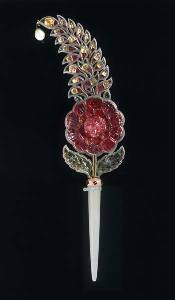
|
Stringed instrument, North India, 1800-1880. Photos Provided by Victoria and Albert Museum |
Visitors can feast on works from the 18th and 19th centuries
For the first time, mysterious Indian rulers and royal life are unveiled in front of Chinese audiences at the Palace Museum - better known as the Forbidden City, igniting sparks from the cultural collision between the two ancient civilizations.
Titled Splendor of India's Royal Courts, the exhibition is curated by the Victoria and Albert Museum in London, a world-leading museum of art and design founded in 1852.
"The exhibition is a unique one specially arranged for the Palace Museum by V&A, and will not be shown anywhere else," says Anna Jackson, keeper of the V&A's Asian department and curator of the exhibition.
The 113 selected works from the V&A's collections of the Indian subcontinent include paintings, textiles, jewelry and thrones, arms and armor as well as instruments.
The treasures are from the 18th and 19th centuries, a remarkable period of great political and cultural change in Indian history.
"Under the patronage of India's rulers, magnificent paintings and objects were created which enhanced their status and identity, and reflected these shifts of power and influence," says Jackson.
 |
|
Turbon ornament, Mughal court, 1700-1750. Photos Provided by Victoria and Albert Museum |
"Darbar" means an Indian ruler's court, the center of rituals attended by courtiers and nobles. But formal events such as the king's birthday were opened to the public, who would get to see the king in his finest clothes and jewelry, as well as armed with ceremonial weapons and surrounded by regalia, signifying his power and royal duties.
A turban ornament exhibited in this section gives a glimpse of the king's splendor. It is shaped like a feather on a big rose, and filled with jade, gold, rubies, emeralds, topaz and pearls. Every gem is accurately cut and placed.
"All the treasured materials such as jade, diamonds and glass would only be afforded by and used by the royal courts to mark their wealth and show their splendor," says Rosemary Crill, senior curator of V&A's Asian department. "At the same time, the courts had their own makers, who would design and make only for the royal families with the finest quality."
The second section, Palace Life, explores the rulers and their consorts' private lives. Costumes, instruments and board games demonstrate their pastimes and pleasures.
"Women who appear in the paintings are imaginary and symbolic instead of real ones. What they do in the picture such as swinging and feeding birds are usually presented with the aspect of romantic love," Crill says.